Box – Die Abholstation ist die Vision der Deutschen Bahn, Bahnhöfe zu einem noch praktischeren Teil des Alltags zu machen. Ob Bestellungen von europaweiten Anbietern oder Lieferungen vom lokalen Blumenladen oder Reinigungsservice – deine Pakete kannst du ganz bequem auf dem Heimweg abholen. Einfach ein sicheres Schließfach am Bahnhof nutzen und los geht’s.
Gemeinsam mit der Deutschen Bahn hat das bitcrowd-Team die Produktanforderungen konzipiert und die besten Voraussetzungen geschaffen, um eine funktionale und barrierefreie Lösung zu entwickeln. In ausführlichen Workshops haben wir jeden Schritt des Prozesses sorgfältig geplant, um die Bedürfnisse aller Stakeholder bestmöglich zu berücksichtigen. Dabei stand die Sicherheit von Box – Die Abholstation stets im Mittelpunkt: Unser Backend-Team entwickelte ein robustes, zukunftssicheres System, das höchsten Sicherheitsstandards entspricht. Gleichzeitig hat unser Frontend-Team in enger Zusammenarbeit mit dem UX- und Visual-Design-Team intuitive, benutzerfreundliche Interfaces geschaffen, die das Nutzererlebnis auf ein neues Level heben.
Seit dem Launch von Box – Die Abholstation haben wir das Produkt sowie die Marketingmaßnahmen kontinuierlich optimiert und weiterentwickelt. Dabei haben wir eine neue Landingpage entworfen und eine interaktive Demo erstellt, mit der die Deutsche Bahn das System auf Messen und Veranstaltungen interessierten Personen anschaulich präsentieren kann.







